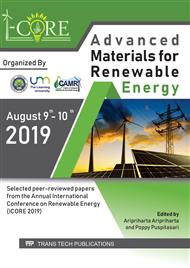[1]
B. Muhammad, M. Ismail, M.A.R. Bhutta, A. Abdul-Majid, Influence of non-hydrocarbon substances on the compressive strength of natural rubber latex-modified concrete, Construction Building Mat. 27 (2012) 241-246.
DOI: 10.1016/j.conbuildmat.2011.07.054
Google Scholar
[2]
J.D. David, H.D. Richaerd, Natural ans synthetic latex polymers, Rapra Technology Limited, United Kingdom(UK), (2002).
Google Scholar
[3]
D. Wititsuwannakul, R. Wititsuwannakul, Biochemistry of natural rubber and structure of latex, In Steinbüchel A (ed), vol 2. Wiley-VCH, Weinheim, Germany, 2001, p.151–202.
DOI: 10.1002/3527600035.bpol2006
Google Scholar
[4]
M. Yikmis, A. Steinbüchel, Historical and Recent Achievements in the Field of Microbial Degradation of Natural and Synthetic Rubber, App. Env. Microbiology, 78(13) (2012) 4543–4551.
DOI: 10.1128/aem.00001-12
Google Scholar
[5]
R.A. Backhaus, Rubber formation in plants—a mini-review, Isr. J. Bot. 34 (1985) 283–293.
Google Scholar
[6]
B. B.Boonstra, Reinforcement by filler, Rubber Technology and Manufacture, Butterwerth & Ce. Ltd. Lenden, 227 (1971).
Google Scholar
[7]
D.E. El_Nashar, A.A. Ward, S.L. Abb-El-Messieh, D. Cairo, Physico-mechanical and dielectric prpertiesof nitrile rubber filled with silica and mica, Elastomers plastics (2009) 434-440.
Google Scholar
[8]
A.M. Rezadoust. M. Esfandeh, evaluation of two-roll mill method for preparing short glass fibre reinforced NBR-phenolic composites, Polymers Pol. Comp. 9(6) (2001) 403-408.
DOI: 10.1177/096739110100900605
Google Scholar
[9]
M. Balachadran, S.S. Bhagawan, Mechanical, thermal and transport properties of nitrile rubber (NBR)-nanoclay composites, J. Pol. Res. 19(2) (2012) 9809-9818.
DOI: 10.1007/s10965-011-9809-x
Google Scholar
[10]
M.S. Sobhy, D.E. El-Nashar, M.A Mazied, Cure characteristics and physicomechanical properties of calcium carbonate reinforcement rubber composites, Egypt J. Sol. 26(2) (2003) 241-257.
DOI: 10.21608/ejs.2003.150162
Google Scholar
[11]
M. Rahaman, T.K. Chaki, D. Khastgir, Development of high permormace EMI shelding material from EVA, NBR, and thei blends: effect of carbon black structure, J. Mat. Sci., 46(11) (2011) 3989-3999.
DOI: 10.1007/s10853-011-5326-x
Google Scholar
[12]
V. Jovanovic, S. Samarzija,-Jovanovic, J. Budinski-Simendic, G. Markovic, Composites based on carbon black reinforced NBR/EPDM rubber blends, Composites Part B: Eng, 45(1) (2013) 333-340.
DOI: 10.1016/j.compositesb.2012.05.020
Google Scholar
[13]
A. Mostafa, A. Abouel-Kasem, M.R. Bayoumi, M.G. El-Sebaie, Effect of carbon black loading on the swelling and compression set behavior of SBR and NBR rubber compounds, Mat. Designs, 30(5) (2009) 1561-1568.
DOI: 10.1016/j.matdes.2008.07.043
Google Scholar
[14]
M.A. Kader, K.Kim, Y.S. Lee, C. Nah, Preparation and properties of nitrile rubber/montmorillonite nanocomposites via latex blending, J. Mat. Sci, 41(22) (2006) 7341-7352.
DOI: 10.1007/s10853-006-0792-2
Google Scholar
[15]
G. George, R. Joseph, S. Thomas, K.T. Varughese, Blends of isostatic polypropylene and nitrile rubber: morphology, mechanical properties and compatibilization, Polymer 36(23) (1995) 4405-4416.
DOI: 10.1016/0032-3861(95)96846-z
Google Scholar
[16]
Y.P. Wu, Q.X. Jia, D.S. Yu, L.O Zhang, Structure and properties of nitrile rubber (NBR)-clay nanocomposites by co-coagulating NBR latex and clay aquaeous suspension, J. App. Pol. 89(12) (2003) 3855-3858.
DOI: 10.1002/app.12568
Google Scholar
[17]
E. Marwanta, T. Mizumo, N. Nakamura, H. Ohno, Improved ionic conductivity of nitrile rubber/ionic liquid composites, Polymer, 46(11) (2005) 3795-3800.
DOI: 10.1016/j.polymer.2005.02.113
Google Scholar
[18]
X. Cao, C. Xu, Y. Wang, Y. Liu, Y. Liu, Y. Chen, New nanocomposite materials reinforced with cellulose nanocrystals in nitrile rubber, Pol. Test., 32(5) (2013) 819-826.
DOI: 10.1016/j.polymertesting.2013.04.005
Google Scholar
[19]
F. Pruneda, J.J. Sunol, F. Andreu-Mateu, X. Colom, Thermal characterization of nitrile butadiene rubber (NBR) PVC Blends, J. Ther. Anal. Calorimetry 80(1) (2005) 187-190.
DOI: 10.1007/s10973-005-0634-5
Google Scholar
[20]
J. Nieuwenhuizen, M. Reedijk, Thiuram and Dithiocarbamate Accelerated Sulfur Vulcanization from the Chemist's Perspective; Methods, Materials and Mechanisms Reviewed. Rubber Chem. Technol. 70(3) (1997) 368-429.
DOI: 10.5254/1.3538436
Google Scholar


